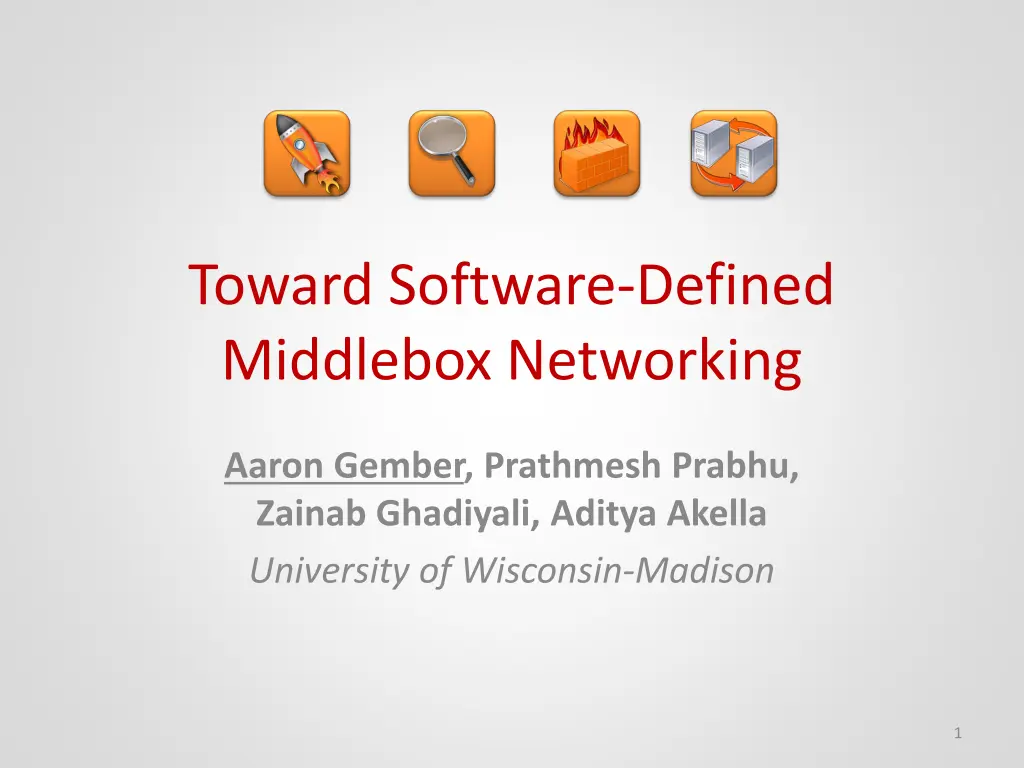
Software-Defined Middlebox Networking Insights
Explore the significance of middleboxes in enterprise networks and delve into topics such as middlebox deployment models, live data center migration, middlebox scaling, and controlling middlebox state. Learn about the key issues surrounding logic division, state manipulation, and interface exposure in software-defined middlebox networking.
Uploaded on | 4 Views
Download Presentation

Please find below an Image/Link to download the presentation.
The content on the website is provided AS IS for your information and personal use only. It may not be sold, licensed, or shared on other websites without obtaining consent from the author. If you encounter any issues during the download, it is possible that the publisher has removed the file from their server.
You are allowed to download the files provided on this website for personal or commercial use, subject to the condition that they are used lawfully. All files are the property of their respective owners.
The content on the website is provided AS IS for your information and personal use only. It may not be sold, licensed, or shared on other websites without obtaining consent from the author.
E N D
Presentation Transcript
Toward Software-Defined Middlebox Networking Aaron Gember, Prathmesh Prabhu, Zainab Ghadiyali, Aditya Akella University of Wisconsin-Madison 1
Why Middleboxes? Enterprises heavily rely on middleboxes Application Application Presentation Presentation ??? Session Session Transport Transport Network Data Link Data Link Network SDN Physical [Sherry et al., SIGCOMM 2012] 2
Middlebox Deployment Models Arbitrary middlebox placement New forms of middlebox deployment (VMs, ETTM [NSDI 2011], CoMB [NSDI 2012]) 3
Live Data Center Migration Move between software-defined data centers Data Center A Data Center B Existing VM and network migration methods Unsuitable for changing underlying substrate Programmatic control over middlebox state 4
Middlebox Scaling Add or remove middlebox VMs based on load Clone VM (logic, policy, and internal state) Unsuitable for scaling down or some scaling up Fine-grained control 5
Our Contributions Classify middlebox state, and discuss what should be controlled Abstractions and interfaces Representing state Manipulating where state resides Announcing state-related events Control logic design sketches 6
Software-Defined Middlebox Networking Today SDN-like Middleboxes IPS App App Controller Middlebox Middlebox 7
Key Issues 1. How is the logic divided? 2. Where is state manipulated? 3. What interfaces are exposed? App App Controller Middlebox Middlebox 8
Middlebox State Configuration input + detailed internal records Src: HostA Server: B Balance Method: Round Robin Server: B CPU: 50% Proto: TCP Port: 22 State: ESTAB Seq #: 3423 Hash: 34225 Content: ABCDE Cache size: 100 Significant state diversity 9
Classification of State Action Supporting Tuning Src: HostA Server: B Balance Method: Round Robin Only affects performance, not correctness Server: B CPU: 50% Proto: TCP Port: 22 State: ESTAB Seq #: 3423 Hash: 34225 Content: ABCDE Cache size: 100 Internal & dynamic Many forms 10
How to Represent State? Per flow Significant diversity Src: HostA Server: B Server: B CPU: 50% 1010110 1000101 May be shared Proto: TCP Port: 22 State: ESTAB Seq #: 3423 1111000 1101010 Unknown structure Policy Language Hash: 34225 Content: ABCDE 0101001 Shared Commonality among middlebox operations 11
State Representation Key Action Supporting Field1 = Value1 FieldN = ValueN Offset1 Const1 OffsetN ConstN Binary Blob Key: protocol header field/value pairs identify traffic subsets to which state applies Action: transformation function to change parts of packet to new constants Supporting: binary blob Only suitable for per-flow state Not fully vendor independent 12
How to Manipulate State? Today: only control some state Constrains flexibility and sophistication Manipulate all state at controller Removes too much functionality from middleboxes Controller Middlebox 13
State Manipulation Determine where state resides Controller IPS 1 IPS 2 Create and update state Control over state placement 1. Broad operations interface 2. Expose state-related events 14
Operations Interface Key SrcIP = 10.10.0.0/16 DPort = 22 Action Filter get ( , ) SrcIP = 10.10.54.41 * Key SrcIP = 10.10.54.41 DstIP = 10.20.1.23 SPort = 12983 DPort = 22 Supporting State = ESTAB add ( , ) DstIP = 10.20.1.0/24 Need atomic blocks of operations Potential for invalid manipulations of state Key Action DROP Source Destination Proto Other Action * 10.20.1.0/24 TCP * DROP Filter remove( , ) 15
Events Interface Triggers Created/updated state Require state to complete operation Contents Key Copy of packet? Copy of new state? Controller Firewall Balance visibility and overhead 16
Conclusion Need fine-grained, centralized control over middlebox state to support rich scenarios Challenges: state diversity, unknown semantics Key Action Supporting Field1 = Value1 Offset1 Const1 Binary Blob get/add/remove ( , ) 17
Open Questions Encoding supporting state/other actionstate? Preventing invalid state manipulations? Exposing events with sufficient detail? Maintaining operation during state changes? Designing a variety of control logics? Providing middlebox fault tolerance? 18
Related Work Simple Middlebox COntrol protocol [RFC 4540] Modeling middleboxes [IEEE Network 2008] Stratos middleboxes in clouds [UW-Madison TR] ETTM middleboxes in hypervisors [NSDI 2011] COnsolidated MiddleBoxes [NSDI 2012] Efficiently migrating virtual middleboxes [SIGCOMM 2012 Poster] LIve Migration of Entire network [HotNets 2012] 19






















